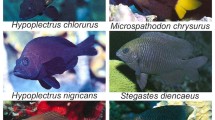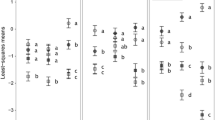Abstract
A number of potential mimetic relationships between coral reef fishes have been described, but the underlying mechanisms are poorly understood. Similarities in colour between species have often been attributed to aggressive mimicry (where predators resemble models in order to deceive prey), however this has not been tested. The fang blenny, Plagiotremus rhinorhynchos is a specialized predator that feeds on tissues of other fishes. Some individuals appear to mimic the harmless cleaner wrasse Labroides dimidiatus in order to deceive fish visiting cleaning stations, thereby increasing access to food. In this study, the ecological relationship between the mimic and model was examined at Kimbe Bay (Papua New Guinea) and the hypothesis that colour similarities represent facultative aggressive mimicry was experimentally evaluated. Some juveniles exhibited a striking resemblance to the juvenile colouration of the cleaner wrasse, but only when in close proximity to the wrasse and only when similar in size. As predicted for mimics, P. rhinorhynchos co-occurred with L. dimidiatus, but was rare relative to the model. Among site comparisons showed that the abundance of mimetic type blennies was positively correlated with the abundance of juvenile cleaner wrasses. Approximately 50% of all P. rhinorhynchos were found ≤1 m from the nearest L. dimidiatus, a distance significantly shorter than expected if they were not associated. A cleaner wrasse removal experiment was carried out to test whether the colour displayed by the blenny and its foraging success were contingent upon the presence of a model. In all cases, removal of the model prompted a rapid colour change to a general non-mimetic colouration in P. rhinorhynchos. Removal of L. dimidiatus also resulted in a ~20% reduction in the average foraging success of the blenny compared to controls, supporting the hypothesis that the blenny is a facultative aggressive mimic of the cleaner wrasse.





Similar content being viewed by others
References
Bates HW (1862) Contributions to an insect fauna of the Amazon Valley. Lepidoptera: Heliconidae. Trans Linn Soc London 23:495–566
Bshary R, Grutter AS (2002) Asymmetric cheating opportunities and partner control in the cleaner fish mutualism. Anim Behav 63:547–555
Bunkley-Williams L, Williams EHJ (2000) Juvenile black snapper, Apsilus dentatus (Lutjanidae), mimic blue Chromis, Chromis cyanea (Pomacentridae). Copeia 2000:579–581
Caley MJ, Schluter D (2003) Predators favour mimicry in a tropical reef fish. Proc R Soc London B Biol Sci 270:667–672
Dafni J, Diamant A (1984) School-oriented mimicry, a new type of mimicry in fishes. Mar Ecol Prog Ser 20:45–50
Deloach N (1999) Reef fish behaviour: Florida, Caribbean, Bahamas, New World, Jacksonville
DeMartini EE, Donaldson TJ (1996) Colour morph-habitat relations in the Arc-eye hawkfish Paracirrhites arcatus (Pisces: Cirrhitidae). Copeia 1996:362–371
Eagle JV, Jones GP (2004) Mimicry in coral reef fishes: ecological and behavioural responses of a mimic to its model. J Zool (in press)
Gilbert LE (1983) Coevolution and mimicry. In: Futuyama DJ, Slatkin M (eds) Coevolution. Sinauer, Sunderland, pp 263–281
Hobson ES (1969) Possible advantages to the blenny Runula azeala in aggregating with the wrasse Thalassoma lucasanum in the tropical eastern Pacific. Copeia 1969:191–193
Joron M, Mallet JLB (1998) Diversity in mimicry: paradox or paradigm? Trends Ecol Evol 13:461–466
Kuiter RH (1995) The juvenile vermicular cod Plectropomus oligacanthus, a mimic of the slender maori wrasse Cheilinus celebicus. Revue Fr Aquariol 21:77–78
Kuwamura T (1981) Mimicry of the cleaner wrasse Labroides dimidiatus by the blennies Aspidontus taeniatus and Plagiotremus rhinorhynchos. Nanki Seibutu 23:61–70
Kuwamura T (1983) Reexamination on the aggressive mimicry of the cleaner wrasse Labroides dimidiatus by the blenny Aspidontus taeniatus (Pisces; Perciformes). J Ethol 1:22–33
Losey GS (1972) Predation protection in the poison-fang blenny, Meiacanthus atrodorsalis, and its mimics, Ecsenius bicolor and Runula laudandus (Blenniidae). Pac Sci 26:129–139
Losey GS (1974) Aspidontus taeniatus: effects of increased abundance on cleaning symbiosis with notes on pelagic dispersion and A. filamentosus (Pisces, Blenniidae). Z Tierpsychol 34:430–435
Mahon JL (1994) Advantage of flexible juvenile colouration in two species of Labroides (Pisces: Labridae). Copeia 1994:520–524
Malcolm SB (1990) Mimicry: status of a classical evolutionary paradigm. Trends Ecol Evol 5:57–62
Marshall NJ (2000) Communication and camouflage with the same ‘bright’ colours in reef fishes. Philos Trans R Soc London B 355:1243–1248
Moyer JT (1977) Aggressive mimicry between juveniles of the snapper Lutjanus bohar and species of the damselfish genus Chromis from Japan. Jpn J Ichtyol 24:218–222
Moynihan M (1968) Social mimicry; character convergence versus character displacement. Evolution 22:315–331
Müller F (1879) Ituna and Thyridia; a remarkable case of mimicry in butterflies. Proc Entomol Soc London 1879:20–29
Munday PL, Eyre PJ, Jones GP (2003) Ecological mechanisms for coexistence of colour polymorphism in a coral-reef fish: an experimental evaluation. Oecologia 442:519–526
Ormond RFG (1980) Aggressive mimicry and other interspecific feeding associations among Red sea coral reef predators. J Zool London 191:247–262
Randall JE, Hoese DF (1986) Revision of the groupers of the Indo-Pacific genus Plectropomus (Perciformes: Serranidae). Indo Pac Fishes 13:31
Randall JE, Randall HA (1960) Examples of mimicry and protective resemblance in tropical marine fishes. Bull Mar Sci 10:444–480
Randall JE, Allen GR, Steene R (1997) Fishes of the Great Barrier Reef and Coral Sea. Crawford House, Bathurst
Russell BC (1976) Disguise, defence and aggression. Aust Nat Hist 18:324–329
Russell BC, Allen GR, Lubbock HR (1976) New cases of mimicry in marine fishes. J Zool 180:407–423
Sanderson GC (1966) The study of mammal movements—a review. J Wildl Manage 30:215–235
Sazima I (2002a) Juvenile snooks (Centropomidae) as mimics of mojarras (Gerreidae), with a review of aggressive mimicry in fishes. Environ Biol Fish 65:37–45
Sazima I (2002b) Juvenile grunt (Haemulidae) mimicking a venomous leatherjacket (Carangidae), with a summary of Batesian mimicry in marine fishes. Aqua J Ichtyol Aquat Biol 6:61–68
Sazima I, Uieda VS (1980) Scale-eating behaviour in Oligoplites saurus and record of scale-eating in O. palometa and O. saliens (Pisces, Carangidae). Rev Bras Biol 40:701–710
Siegel JA, Adamson TA (1983) Batesian mimicry between a cardinalfish (Apogonidae) and a venomous scorpionfish (Scorpaenidae) from the Philippine Islands. Pac Sci 37:75–79
Smith-Vaniz WF (1976) The saber-toothed blennies, tribe Nemophini (Pisces: Blennidae). Acad Nat Sci Philadelphia Monogr 19:1–196
Smith-Vaniz WF, Satapoomin U, Allen GR (2001) Meicanthus urostigma, a new fangblenny from the Northeastern Indian Ocean, with discussion and examples of mimicry in species of Meiacanthus (Teleostei: Blenniidae: Nemophini). Aqua J Ichtyol Aquat Biol 5:25–43
Snyder DB (1999) Mimicry of initial-phase bluehead wrasse, Thalassoma bifasciatum (Labridae) by juvenile tiger grouper, Mycteroperca tigris (Serranidae). Rev Fr Aquariol 26:17–20
Snyder DB, Randall JE, Michael SW (2001) Aggressive mimicry by the juvenile of the redmouth grouper Aethaloperca rogaa (Serranidae). Cybium 25:227–232
Springer VG, Smith-Vaniz WF (1972) Mimetic relationships involving fishes of the family Blenniidae. Smithson Contrib Zool 112:1–36
Thresher RE (1978) Polymorphism, mimicry, and the evolution of the hamlets (Hypoplectrus, Serranidae). Bull Mar Sci 28:345–353
Turner JRG (1995) Mimicry as a model for coevolution. In: Arai R, Kato M, Doi Y (eds) Biodiversity and evolution. The National Science Museum Foundation, Tokyo, pp 131–150
Wickler W (1961) Über das Verhalten der Blenniiden Runula und Aspidontus (Pisces; Blenniidae). Z Tierpsychol 18:421–440
Wickler W (1965) Mimicry and the evolution of animal communication. Nature 208:519–521
Wickler W (1968) Mimicry in plants and animals, McGraw Hill, New York
Zar JH (1999) Biostatistical analysis, Prentice Hall, New Jersey
Acknowledgements
We thank M. Barbosa and A. Pettersen for valuable field assistance, and P.L. Munday and M. Srinivasan for constructive comments on the manuscript. Logistic support was provided by the Mahonia Na Dari Research and Conservation Centre, and the Walindi Plantation Resort. An Australian Research Council Grant to G.P.J. supported this project.
Author information
Authors and Affiliations
Corresponding author
Rights and permissions
About this article
Cite this article
Moland, E., Jones, G.P. Experimental confirmation of aggressive mimicry by a coral reef fish. Oecologia 140, 676–683 (2004). https://doi.org/10.1007/s00442-004-1637-9
Received:
Accepted:
Published:
Issue Date:
DOI: https://doi.org/10.1007/s00442-004-1637-9




